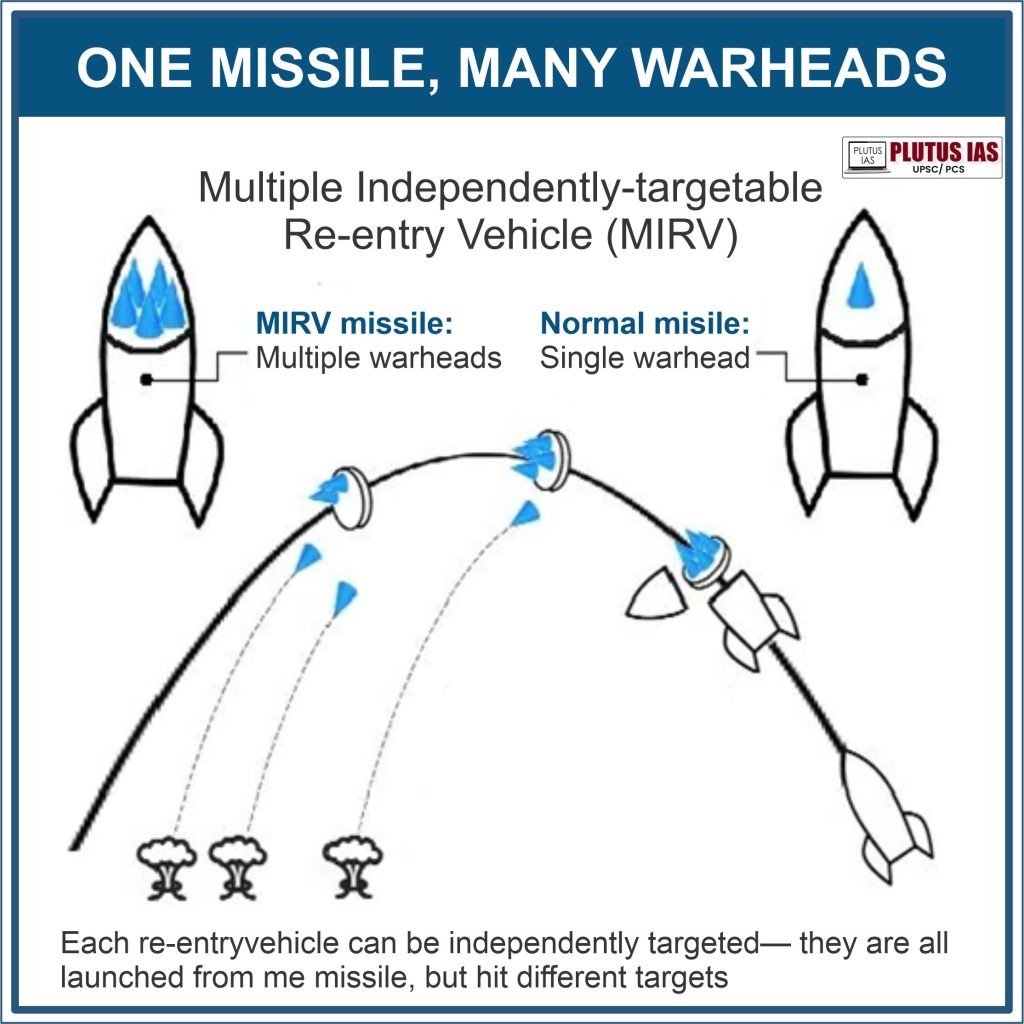14 Mar Agni-5 Missile Test with MIRV Technology
This article covers ‘Daily Current Affairs’ and the topic details of ”Agni-5 Missile Test with MIRV Technology”. This topic is relevant in the “Security” section of the UPSC CSE exam.
Why in the News?
The recent test of India’s Agni-5 Missile, featuring Multiple Independently Targetable Reentry Vehicle (MIRV) technology and boasting multiple warhead capabilities, signifies a significant advancement in the country’s defense capabilities. This achievement, named Mission Divyastra, highlights a notable milestone in India’s defence capabilities.
MIRV Technology
MIRV, or Multiple Independently Targetable Reentry Vehicle technology, is a game-changer in the world of missiles. It allows a single missile to carry a punch far greater than its traditional counterparts.
- Multiple Warheads: Unlike a standard missile with just one explosive payload, a MIRV-equipped missile can carry several warheads. A single missile acts like a multi-headed serpent, each head aimed at a different target.
- Independent Targeting: These warheads aren’t simply passengers on the missile ride. Each one is equipped with its own guidance system, allowing it to be programmed to hit a specific location with pinpoint accuracy.
- Enhanced Destruction: This independent targeting capability unlocks a range of possibilities. The warheads can be programmed to strike multiple targets simultaneously, causing widespread devastation. Alternatively, they can be unleashed in a sequential attack on a single target, ensuring complete annihilation.
History of MIRV: From Cold War Innovation to Modern Deterrence
While the recent headlines might suggest MIRV technology is a cutting-edge innovation, its roots lie deeper in history. This technology emerged during the intense competition of the Cold War.
- Cold War Genesis (1960s): The 1960s witnessed the development of MIRV by the superpowers – the United States and the Soviet Union. This technology presented a significant leap forward in missile capabilities. The key challenge involved miniaturising warheads, equipping them with independent guidance systems, and ensuring their sequential release from the missile.
- Proliferation Throughout the Decades: Over time, MIRV technology wasn’t confined to the Cold War giants. Countries like France, the United Kingdom, and China successfully developed this capability. Even Pakistan claims to have tested a MIRV-equipped missile called Ababeel in recent years.

Advantages of MIRV
The allure of MIRV extends beyond its ability to inflict widespread damage in a single attack. It offers several strategic benefits:
- Bypassing Missile Defenses: Modern missile defence systems rely on complex networks of radars and interceptor missiles to neutralise incoming threats. However, MIRV missiles, with their multiple warheads and independent trajectories, present a significant challenge. Decoy warheads can further confuse these systems, potentially rendering them ineffective against a MIRV attack.
- Deterrence Through Overwhelming Force: The sheer destructive power of a single MIRV-equipped missile, capable of unleashing a multi-pronged attack, serves as a strong deterrent against potential adversaries. The potential consequences of a MIRV strike compel nations to think twice before initiating conflict.
Mission Divyastra
- “Mission Divyastra” successfully test-launched the indigenously developed Agni-5 missile equipped with MIRV technology. This achievement marks a major leap for DRDO and India’s strategic arsenal.
- MIRV allows a single Agni-5 to carry multiple warheads, each programmable to strike separate targets, significantly multiplying its destructive potential. This bolsters India’s deterrence against potential threats, particularly with Agni-5’s 5,000+ km range.
- Developing MIRV is complex, requiring expertise in building large missiles, miniaturised warheads, and precise guidance systems. India’s success places it among a select group of nations with this advanced capability.
Agni Missiles
- The Agni series is India’s workhorse in the realm of long-range ballistic missiles. These missiles, capable of carrying nuclear warheads and striking targets hundreds to thousands of kilometres away, form a critical part of India’s strategic deterrence arsenal.
- The journey of Agni missiles began in 1989 with the successful test launch of Agni-I, developed under the Integrated Guided Missile Development Program (IGMDP).
- Recognising its immense strategic significance, the Agni program was soon elevated to a dedicated initiative within India’s defence budget, ensuring dedicated funding for further development.
The Agni series encompasses a range of missiles, each tailored for specific strategic needs:
- Agni-I and Agni-II: Classified as Medium Range Ballistic Missiles (MRBMs), these missiles possess a range of 700-800 km and over 2,000 km, respectively, providing a potent deterrent against regional threats.
- Agni-III and Agni-IV: Stepping into the Inter-Medium Range Ballistic Missile (IRBM) category, Agni-III and Agni-IV boast extended ranges exceeding 2,500 km and 3,500 km, respectively. Notably, Agni-IV is equipped with a road-mobile launcher, enhancing its operational flexibility.
- Agni-V: The current crown jewel of the Agni series, Agni-V is classified as an Inter-Continental Ballistic Missile (ICBM) with a range exceeding 5,000 km. This allows India to potentially engage targets at long distances.
- Agni-VI: The future of the Agni lineage lies with Agni-VI, which is currently under development. This missile is envisioned as an even more advanced ICBM with a projected range of 11,000-12,000 km, significantly bolstering India’s long-range strike capabilities.
Download plutus ias current affairs eng med 14th March 2024
Main practise question
Q1. While MIRV offers deterrence, are there any potential drawbacks to India possessing this technology? Consider factors like regional stability and arms control efforts.
Q2. Developing advanced weaponry like MIRV missiles requires significant resources. How might this impact India’s spending on other national security priorities or social programs?
I am a content developer and have done my Post Graduation in Political Science. I have given 2 UPSC mains, 1 IB ACIO interview and have cleared UGC NET JRF too.



No Comments